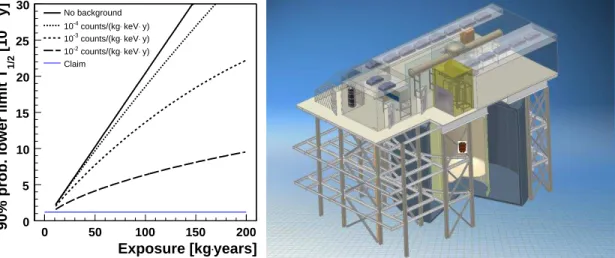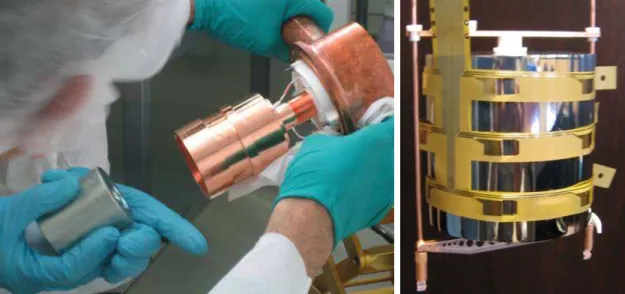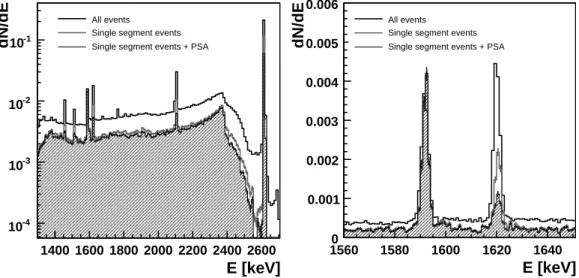The GERDA Neutrinoless Double Beta-Decay Experiment
Béla A. Majorovits for the GERDA collaboration
Max Planck Institut für Physik, Föhringer Ring 6, 80805 München, Germany
Abstract. Neutrinoless double beta (0νββ)-decay is the key process to gain understanding of the nature of neutrinos. The GErmanium Detector Array (GERDA) is designed to search for 0νββ- decay of the isotope76Ge. Germanium crystals enriched in 76Ge, acting as source and detector simultaneously, will be submerged directly into an ultra pure cooling medium that also serves as a radiation shield. This concept will allow for a reduction of the background by up to two orders of magnitudes with respect to earlier experiments.
Keywords: Neutrinoless Double Beta-Decay, Germanium Detectors PACS: 23.40.-s, 12.15.Ff, 14.60.St, 29.40.Wk
INTRODUCTION
Neutrino accompanied double beta-decay is an allowed second order weak process. Only if the neutrino is a massive Majorana–particle the decay can also occur without the emission of a neutrino [1]. The GERmanium Detector Array, GERDA [2], is designed to search for the 0 νββ -decay of
76Ge. The importance of such a search is emphasized by the observation of a non-zero neutrino mass of yet unknown scale from flavor oscillations [3]. The observation of neutrino-oscillation do allow for two different mass scenarios with a normal or an inverted hierarchy [4]. These can be disentangled by 0 νββ -decay for a Majorana neutrino if a sensitivity for the effective Majorana neutrino- mass of
10 meV can be achieved [5].
The most sensitive 0 νββ experiments so far are based on High-Purity-Germanium, HPGe, detector technology. This is due to the combination of a very good energy resolution of the detectors at the Q
ββ-value of
76Ge, the very high purity of the detectors (very low intrinsic background) and the high signal detection efficiency of an experiment with the detector being equal the source.
Currently the Heidelberg-Moscow (HdMo) and IGEX experiments give limits on the lifetime of 0 νββ -decay of 1.9
10
25y and 1.6
10
25y, respectively (90% C.L.) [6, 7]. These lower limits can be translated into upper limits for the effective Majorana neutrino-mass in the range between 0.35 eV-1.2 eV and 0.3 eV-1.5 eV for the two experiments for different matrix elements (see [6, 7] and references therein). A part of the HdMo collaboration claims to have observed a peak at Q
ββwith 4.2 σ confidence level which can be attributed to 0 νββ -decay with a half-life of T
0νββ1=2
=1.19
+20:99:50
10
25y
(3 σ range) [8].
years]
⋅ Exposure [kg
0 50 100 150 200
y]25 [10 1/290% prob. lower limit T 0
5 10 15 20 25
30 No background
⋅ y)
⋅ keV counts/(kg 10-4
⋅ y)
⋅ keV counts/(kg 10-3
⋅ y)
⋅ keV counts/(kg 10-2
Claim
FIGURE 1. Left: Expected 90% probability lower limit on T0νβ β
1=2 as a function of exposure for different background indices (taken from [9]). Right: Schematic view of the GERDA setup. The detector array is sitting in the center of the cryostat. The cryo tank is surrounded by a water buffer serving as additional shield and as a muon- ˇCerenkov veto system. The detector array is loaded through a lock system located in a clean-room on the top of the tank.
SENSITIVITY AND THE PRINCIPLES OF GERDA
The sensitivity obtainable in double beta experiments with an energy resolution of 5 keV at the Q-value with a given exposure and background index is displayed in the left panel of Fig. 1. The expected 90 % probability lower limit as a function of exposure for given background indices are shown. The values were calculated using Monte-Carlo ensemble test on the basis of Bayesian statistics [9].
For a given exposure the background limits the sensitivity. Therefore the goal is to minimize the background. This can be achieved by using an ultra-pure cryogenic liquid as the cooling medium and as a shield against gamma radiation simultaneously [10].
The cryostat will be made out of carefully selected stainless steel. Additionally it will contain a low-background copper inlet as a radiation shield against the steel of the cryo- tank. The cryogenic volume is surrounded by a buffer of ultra-pure water acting as an additional gamma and neutron shield. The water buffer is additionally used as a muon- Cerenkov veto. The setup is schematically depicted in Fig. 1. ˇ
GERDA will be installed in Hall A of the Gran Sasso underground laboratory (LNGS), Italy. The experiment is foreseen to proceed in two phases. In the first phase, enriched detectors which were previously operated by the HdMo and IGEX collab- orations will be re-deployed. If the HdMo claim is correct, 6.0
1.4 events above a background of 0.5 events after one year of measurement (15 kg
y) are expected.
This will be enough to either confirm or refute the claim from the HdMo experiment
(see Fig. 1). In the second phase custom made segmented detectors will be installed
which have a true coaxial geometry. An exposure of 100 kg
y with a background level
of 10
3counts/(kg
keV
y) is foreseen. A lower limit on the half-life of 0 νββ -decay
of higher than 1.5
10
26y corresponding to an upper limit of
140 meV (using the
corrected matrix elements from [11]) can be set with 90 % probability if no signal is
observed.
MAIN BACKGROUND SOURCES
Monte Carlo studies using the GEANT 4 application MaGe [12] were performed to estimate the background expected for Phase II of the GERDA experiment. The detector geometries assumed reflect the design of the first segmented prototype detector that has been developed and successfully operated [13].
A background of
5
10
4counts/(kg
keV
y) is expected from internal contamina- tions of the detector (after two years of storage underground). The origin of this back- ground is mainly cosmogenic
68Ge and
60Co. This background can be reduced by mini- mizing the exposure of the germanium to cosmic rays. Since
68Ge decays with a half-life of T
1=2
=271 d, this component decreases by a factor of 2.54 per year.
A contribution of
5
10
4counts/(kg
keV
y) is expected from the detector infras- tructure, i.e. detector support, cabling and electronics. Presently for the cabling and holder system 2.5 g of copper on Kapton cable, 31g of copper and 7 g of PTFE are used per detector in the direct vicinity of the crystals. Material selection and material minimization that could lead to a considerable decrease of this background component are under way.
Roughly 3
10
5counts/ (kg
keV
y) are expected from the external infrastructure (cryo-tank, water shield, etc.) from
208Tl and
214Bi photons being negligible compared to the dominant background sources.
Neutrons and muons are expected to yield roughly 2
10
4counts/(kg
keV
y) with an important contribution being due to the delayed decay of
77Ge produced by the neutron capture on
76Ge [14].
During the lifetime of the experiment the internal background will further decrease.
In connection with the ongoing work on material selection this will ensure that the goal of a total background index of less than 10
3counts/(kg
keV
y) can be reached.
PHASE I AND PHASE II STATUS
All IGEX and HdMo detectors are presently stored underground. They have been re- moved from their cryostats without any technical problems. The left panel of Fig. 2 shows the dismounting of the first enriched HdMo detector. The detectors are presently being refurbished and will then be installed into the phase I suspension. A prototype de- tector has been operated in liquid argon in the holder at LNGS since beginning of 2006.
It has gone through more than twenty cooling and warming up cycles.
The enriched materials for phase II of the experiment, 35.5 kg of germanium enriched to 87%-88% in
76Ge in form of GeO
2, have been procured and were transported from Siberia to Germany in a steel cylinder designed to reduce cosmogenic activation. The material was unloaded and weighed and is now stored in a 500 mwe underground site.
The phase II detectors will be segmented true coaxial n-type, 18-fold in the presently
working prototype design. The segmentation will help to identify multiple Compton-
FIGURE 2. Left: Dismounting of first enriched detector of the HdMo experiment from its copper vacuum-cryostat. Right: Germanium crystal with the new contacting scheme in its low mass holder. The 18 segments are contacted by pressing the contact pads of Kapton printed circuit boards onto the segment contact area.
scattering events in the region of interest. As shown in [15] the Compton background can be identified with high efficiency depending on its source and location.
A prototype detector (see right panel of Fig. 2) was produced. The 18 segments are read out using a novel contacting scheme described in [13]. The prototype detector was extensively tested in a conventional test cryostat. The energy resolution of all signals and the core were around 3 keV at 1.3 MeV. Details of the setup can be found in [13]. Fig. 3 shows a spectrum taken with a
228Th calibration source. Three spectra are shown: The full spectrum as measured by the core electrode, the spectrum of events in which an energy deposition
20 keV was detected in a single segment only (single segment events) and the spectrum with single segment events after application of pulse shape analysis (PSA). The left panel shows the energy spectrum up to 2.7 MeV, the right panel shows the energy region around the double escape peak of the 2.615 MeV gamma and the 1620 keV Compton peak. The Compton background discrimination works well and was a factor of three around 2 MeV for this configuration. The data could be reproduced very well by Monte Carlo simulations [15]. The double escape peak is only marginally reduced by application of the single segment requirement and remains basically unchanged after further application of PSA. The Compton peak is suppressed by requiring single segment events. PSA further reduces the peak by removing events close to the segment boundaries [16].
CONCLUSIONS
The Gerda neutrinoless double beta-decay experiment will be installed in the LNGS
underground laboratory. In the first phase an exposure of
15 kg
y with a background
E [keV]
1400 1600 1800 2000 2200 2400 2600
dN/dE
10-4
10-3
10-2
10-1
All events
Single segment events Single segment events + PSA
E [keV]
1560 1580 1600 1620 1640
dN/dE
0 0.001 0.002 0.003 0.004 0.005 0.006
All events
Single segment events Single segment events + PSA
FIGURE 3. 228Th calibration measurement of the 18-fold segmented prototype detector. The left panel shows the full spectrum up to 2.7 MeV, the right panel shows the energy region around the double escape peak of the 2.615 MeV gamma and the 1620 keV Compton peak (taken from [16]). See text for more details.
index of 10
2counts/(kg
keV
y) are planned. This will allow to check the claim of a positive evidence based on the HdMo experiment data. The goal of the second phase of the experiment is to collect 100 kg
y of data with a background index of not more than 10
3counts/(kg
keV
y). This will allow to set a lower limit for the 0 νββ half life of 1.5
10
26y (90%C.L.) corresponding to an upper limit of the effective Majorana neutrino- mass of 140 meV. According to the Monte Carlo calculations and the material screening done so far this goal can be achieved. The successfully dismounted IGEX and HdMo detectors for phase I are being refurbished. A first prototype 18-fold segmented n-type HPGe detector has been produced and checked. Its performance fulfills all expectations.
REFERENCES
1. S. Elliott and P. Vogel, Ann. Rev. Nucl. Part. Sci 52(2002)115 2. I. Abt et al., hep-exp/0404039
3. S. Fakuda et al., Phys. Rev. Lett. 82(1999)2644 and C. Ahmad et al., Phys. Rev. Lett 92(2004)181301 4. S. Bilenky et al., Phys. Rev. C 64(2001)053010
5. F. Feruglio et al., Nucl. Phys. B 637(2002)345 6. L. Baudis et al., Phys. Rev. Lett. 83(1999)41 7. C. Aalseth et al., Phys. Rev. D 65(2002)092007
8. H.V. Klapdor-Kleingrothaus et al., Phys. Lett. B 586(2004)198 9. A. Caldwell and K. Kröninger, Phys. Rev. D 74(2006)092003 10. G. Heusser, Ann. Rev. Nucl. Part. Sci. 45 (1995)543
11. V. Rodin et al., Nucl. Phys. A 766(2006)107 and V. Rodin, et al., arXiv:0704.4304 12. M. Bauer et al., J. Phys. Conf. Series 39(2006)362
13. I. Abt et al., Nucl. Instr. Meth. A 577(2007)574 14. L. Pandola et al., Nucl. Instr. Meth. A 570(2007)149 15. I. Abt et al., Nucl. Instr. Meth. A (2007)479
16. I. Abt et al., arXiv:0704.3016, accepted for publication by European Physical Journal C


